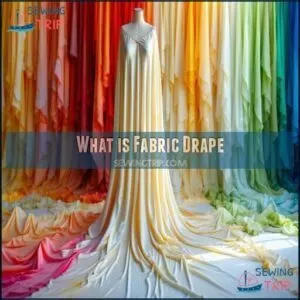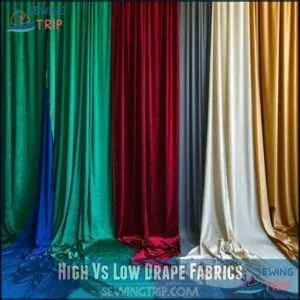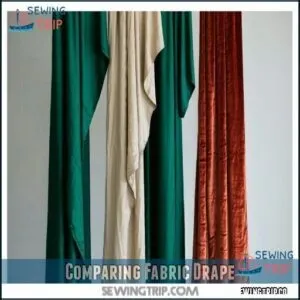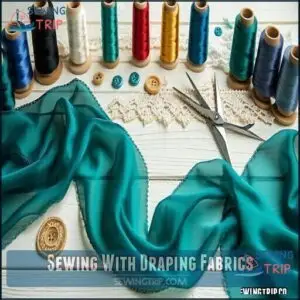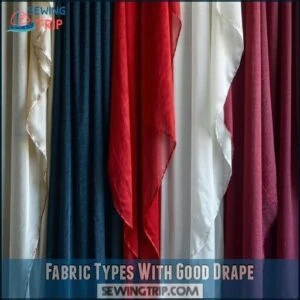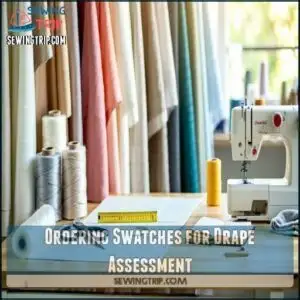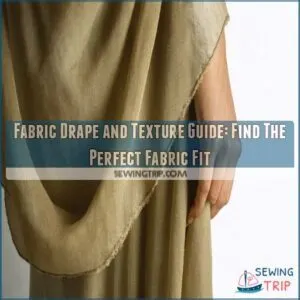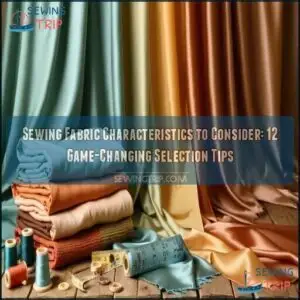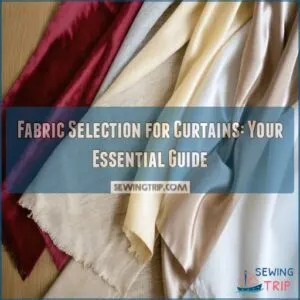This site is supported by our readers. We may earn a commission, at no cost to you, if you purchase through links.
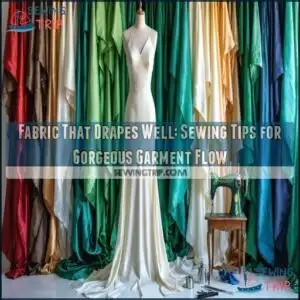
Fabrics like silk, chiffon, rayon, and satin are the rockstars of drape—they’re soft, lightweight, and fall beautifully against the body.
Picture a summer breeze catching a long chiffon dress—it’s all about movement and fluidity.
Be cautious, though: these fabrics can be slippery and tricky to handle, so a fine needle and lots of pins are your best friends.
Avoid stiff fabrics like denim or corduroy; they tend to stand up more than flow down.
Want pro sewing tips? Stick around!
Table Of Contents
Key Takeaways
- Pick lightweight and flowy fabrics like silk, chiffon, rayon, or satin for sewing garments with excellent drape.
- Use tools like fine needles, sharp shears, and lots of pins to handle slippery fabrics with ease.
- Always test fabric drape by holding or draping it over your arm to check how it flows and behaves.
- Match fabric drape to your project’s design—choose high-drape fabrics for elegant dresses and low-drape fabrics for structured pieces.
What is Fabric Drape
Fabric drape is how a material hangs, flows, or clings, shaping the look and feel of a garment.
Think of it like testing spaghetti—some fabrics are stiff like undercooked noodles, while others flow like a perfect al dente swirl, which can be described as having a specific type of drape.
Testing fabric drape is like pasta—stiff like undercooked noodles or silky smooth like perfect al dente strands.
Definition of Fabric Drape
Fabric drape describes how fabric falls, flows, and conforms to shapes, influencing its overall look and feel.
Fabric drape is the art of how fabric dances, shaping elegance with every fold, flow, and contour.
Whether it’s soft drape fabric clinging gracefully or stiffer options adding structure, the fluidity and creasing characteristics matter.
Drapey fabrics, like those with good flow, showcase excellent drape quality.
Stiffness influences how fabrics hang, shaping their falling characteristics beautifully.
Importance of Fabric Drape in Sewing
Think of fabric drape as the secret sauce to your sewing mastery. It shapes a garment’s fit and flattery, turning ordinary into extraordinary.
Here’s why drapey fabrics matter:
- Enhances garment appearance with soft drape fabric.
- Matches pattern selection to project suitability.
- Boosts design enhancements like pleats.
- Guarantees fabric with good flow elevates movement.
- Achieves good drape material elegance.
The provided list outlines the importance of considering fabric drape in sewing projects, highlighting its impact on both the appearance and functionality of a garment.
Factors Affecting Fabric Drape
Understanding fabric drape starts with how fabric stiffness and thickness impact flow—stiff fabrics resist movement, while thinner ones drape gracefully.
Looser weave structures create flexibility, boosting fabric weave drape.
Even moisture content and finishing treatments, like softeners, can tweak the outcome.
Fabric weight, content, and weave all team up like ingredients in a recipe, shaping the final drape beautifully.
High Vs Low Drape Fabrics
If you’ve ever wondered why some fabrics flow like water while others hold their shape like a cardboard box, it all comes down to drape.
Understanding the difference between high-drape and low-drape fabrics helps you pick the perfect material for your project, whether you’re crafting a breezy dress or structured pants.
Characteristics of High-Drape Fabrics
High-drape fabrics, like silk or rayon, offer unmatched fluidity and flow, gracefully hanging with small creases and a softness factor that’s hard to ignore.
These fabrics cling to the body, creating elegant garments perfect for dresses or blouses.
Their drape quality transforms designs into wearable art.
Understanding how fabric weight affects drape is essential for achieving the desired look.
| High-Drape Characteristics | Details |
|---|---|
| Fluidity and Flow | Moves effortlessly |
| Cling to Body | Enhances fit |
| Small Creases | Subtle, delicate |
| Softness Factor | Luxurious feel |
Characteristics of Low-Drape Fabrics
Low-drape fabrics like denim and corduroy are stiff, holding their shape perfectly for structured garments.
They’re ideal when you want volume creation or shape retention—think jackets or pencil skirts.
These rigid fabrics resist flowing and fall in wide folds.
To compare qualities, check these basics:
| Feature | Low-Drape Fabrics |
|---|---|
| Stiffness | High |
| Creases | Wide and Defined |
| Volume Created | Substantial |
| Shape Retention | Excellent |
| Best For | Structured Garments |
They have distinct characteristics, including high stiffness and the ability to create substantial volume, making them perfect for garments that require excellent shape retention.
Choosing Between High and Low Drape
Choosing between high and low drape depends on your garment silhouette and aesthetic goals.
High-drape fabrics flow beautifully for dresses, while low-drape fabrics add structure to custom styles.
Match drape to body shapes and project suitability for the best results.
| Factor | High-Drape | Low-Drape | Tips |
|---|---|---|---|
| Movement | Flowy, soft | Stiff, structured | Mix fabric combinations for balance. |
| Garment Silhouette | Skirts, blouses | Jackets, pants | Plan for fabric stiffness. |
| Body Shapes | Clings gently | Holds shape | Choose to highlight or minimize. |
| Aesthetic Goals | Elegant, relaxed | Bold, fitted | Align with your design focus. |
Assessing Fabric Drape
To assess fabric drape, you’ll want to see how it flows, bends, and hangs when handled.
Whether you’re draping it over your arm or pinching it between your fingers, fabric can surprise you—some stiff-looking materials might flow beautifully, while others cling like static socks!
Observing Fabric Behavior
Noticing fabric drape starts with how it naturally falls. Hold a piece up—watch that drape in motion! Does it flow like silk or stand stiff like denim?
Play around with pleating effects or gathering behavior. Drape it over your arm to see the bias impact.
Fluid fabrics like rayon or knits drape effortlessly, perfect for layering drape magic.
- Hold fabric mid-air for natural flow.
- Test pleats and gathers for movement.
- Pull fabric on the bias, checking stretch.
- Layer pieces to explore overlapping textures.
Comparing Fabric Drape
When comparing fabric drape, trust your eyes and hands.
Lay fabrics side by side, noting their flow and flexibility. Test their drape applications by hanging them or draping them over your arm.
Drape measurement can feel subjective, but fabric weight drape, content drape, and weave drape all play roles.
Historical drape styles show how subtle differences shape cultural significance and garment beauty.
Fabric choices impact durability and longevity, which is a key factor in determining the overall longevity of a garment.
Sewing With Draping Fabrics
When sewing with draping fabrics, you’ll need patience and a steady hand, as these materials tend to slip and shift.
Don’t worry though—choosing the right tools and techniques can make the process smoother, and maybe even fun!
Tips for Working With High-Drape Fabrics
When sewing with high-drape fabrics, avoid fabric slippage by using clips or pins liberally—seriously, you’ll thank yourself later.
Opt for a fine needle, like size 70, for a clean stitch. For those seeking quality sewing tools, many options are available.
Prevent fraying with seam finishes like French seams. Cutting challenges? Use sharp shears and cut single layers.
Tips for Working With Low-Drape Fabrics
Working with stiff fabrics doesn’t have to feel like wrestling a plank.
For low-drape fabrics, embrace shaping techniques like using interfacing to add flexibility and precision. Opt for clean seam finishes to prevent bulky edges, and don’t skip pattern adjustments for better fit.
Heavy-duty needles are essential for piercing thick materials. These sewing tips help tame rigid fabrics, ensuring they shine in structured, flattering designs every time, with a focus on better fit.
Common Mistakes to Avoid
Skipping the prep can ruin your masterpiece.
Don’t rush projects—plan thoroughly.
Ignoring the grainline? That’s like ignoring traffic signs!
Stretching fabric while cutting or using improper tools messes with drapability, making flowing materials look stiff.
And maintenance matters—treat your fabric right.
Skip these sewing mistakes, and your drapey fabric will shine with elegance instead of chaos.
Selecting Fabrics for Drape
When picking fabrics, it’s all about how they hang and flow because the drape can make or break your garment.
Grab a swatch, drape it over your arm, and watch how it behaves—think less cardboard, more liquid gold!
Fabric Types With Good Drape
When choosing the best draping fabric, certain types shine for their flow and elegance.
For garments like stunning dresses, here are five favorites:
- Silk Chiffon – Lightweight with fantastic sheerness.
- Rayon Voile – Known for soft flow.
- Crepe Silk – Beautifully smooth in hang.
- Polyester Satin – Luxurious, wrinkle-resistant.
- Viscose Lawn – Fluid yet easy to handle.
You can find quality silk chiffon for various projects.
Ordering Swatches for Drape Assessment
Ordering swatches lets you truly feel a fabric’s drape before committing.
Test how silk or rayon fabric drapes by draping swatches over your arm or pinching them.
Launder swatches to see changes in flow.
Keep them organized for easy swatch comparison later.
Fabric weight impacts drape, so consider this when ordering swatches.
Ideal swatch size? At least 4 inches!
needs
testing
impact
drape
ready
Frequently Asked Questions (FAQs)
What are the best fabrics for draping a dress?
Isn’t it ironic how silk, chiffon, satin, and rayon seem to defy gravity?
These flowy fabrics, light yet bold, drape wonderfully for dresses, clinging softly to shapes, making you look effortlessly stunning.
Which fabric has a high drape?
Silk, rayon, and chiffon are top picks for high drape.
They flow like water, hugging curves and creating graceful folds.
Perfect for elegant dresses, these fabrics add that wow factor to every garment.
What is a fabric drape?
Imagine holding fabric that flows like water—drape describes how fabric falls, flows, and hangs.
It’s all about its stiffness or fluidity, shaping how it hugs, skims, or stands away from the body.
Which fabrics have almost no drape?
Fabrics with almost no drape are denim, corduroy, canvas, and upholstery materials.
These are more structured, holding their shape firmly.
They’re perfect for projects needing stiffness, like jackets, structured skirts, or even home décor items.
Which fabric has low drape?
Fabrics with low drape, like denim, corduroy, or heavy canvas, feel stiffer and hold their shape well.
They’re great for structured projects like jackets or pants, but don’t expect them to flow or flutter!
What is the best fabric for wedding drapes?
For elegant wedding drapes, go with lightweight, flowy fabrics like chiffon, voile, or organza.
They hang beautifully, create a romantic vibe, and catch light perfectly.
Plus, they’re breathable, so no suffocating reception décor disasters, making them a great choice for a beautiful wedding setting.
How does fabric drape affect tailoring techniques?
Who knew fabric drape could make or break tailoring?
A stiff fabric fights your every move, while a flowy one demands precision.
Pick wisely—matching drape to design guarantees smooth seams, perfect fit, and fewer headaches.
Can fabric drape change after repeated washes?
Yes, fabric drape can change after repeated washes.
Frequent washing might soften stiff fabrics or make delicate ones lose structure, shrink, or wrinkle more—so always follow care instructions to keep your fabric flowing beautifully.
Keep your fabric flowing beautifully.
What fabric linings enhance drape in garments?
Think of linings as the secret sauce to perfect drape.
Lightweight options like silk habotai, rayon bemberg, or polyester charmeuse work wonders.
They add fluidity, reduce friction, and let your garment flow effortlessly.
How does texture influence fabric drape characteristics?
Texture plays a big role in fabric drape!
Smooth fabrics, like silk, flow easily, creating soft folds.
Rougher textures, like denim, resist movement, holding their shape.
Texture affects how fabric clings or stands away stylishly.
Conclusion
Mastering the art of sewing with fabric that drapes well is like learning to dance with your materials—grace and control matter equally.
Choose soft, flowy options like silk or rayon to create stunning garments that move beautifully.
Use fine needles, pins, and lots of patience to handle tricky textures.
Don’t skip testing fabric behavior before cutting; it’s worth the extra effort to ensure your sewing projects will flow as effortlessly as your fabrics.

